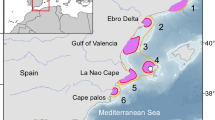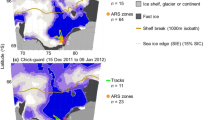Abstract
The marine environment is being increasingly exploited by fisheries and the oil and gas industry. Conservationists urgently need the ability to identify the processes that determine patterns of abundance of marine species. We describe a preliminary Geographic Information System (GIS) in which spatial data on environmental variables (seabird colony locations, sea depth and seabed sediments) are integrated with realistic energy constraints faced by marine birds during the breeding season. A simple foraging model predicts the spatial variation in the quality of given locations as potential feeding sites under different feeding conditions and stages of the breeding cycle. We show how the approach can be used to help managers identify key marine areas and assess the impacts of environmental change or damage.
Similar content being viewed by others
References
Anon. 1986.I:250 000 series, sea bed sediments and quaternary geology. Tay-Forth sheet British Geological Survey, Keyworth, UK.
Anon. 1993. Program and Abstracts. In:Exxon Valdez Oil Spill Symposium, pp. 231–267. Exxon Valdez Oil Spill Trustee Committee, Anchorage, AK.
Anon. 1995.Report of the Working Group on the Assessment of Norway Pout and Sandeel. ICES CM 1995/Assess: 5.
Bryant, D.M. & Furness, R.W. 1995. Basal metabolic rates of North Atlantic seabirds.Ibis 137: 219–226.
Carter, I.C., Williams, J.M., Webb, A. & Tasker, M.L. 1993.Seabird concentrations in the North Sea: An atlas of vulnerability to surface pollutants. Joint Nature Conservation Committee. Aberdeen, UK.
Dunn, E.H. 1975. Caloric intake of nestling double-crested cormorants.Auk 92: 553–565.
Grémillet, D., Argentin, G., Schulte, B. & Culik, B.M. 1998. Flexible foraging techniques in breeding cormorantsPhalacrocorax carbo and shagsPhalacrocorax aristotelis: benthic or pelagic feeding.Ibis 140: 113–119.
Harris, M.P. & Wanless, S. 1991. The importance of the lesser sandeelAmmodytes marinus in the diet of the shagPhalacrocorax aristotelis.Ornis Scand. 22: 375–383.
Hislop, J.R.G., Harris, M.P. & Smith, J.G.M. 1991. Variation in the calorific value and total energy content of the lesser sandeel (Ammodytes marinus) and other fish preyed on by seabirds.J. Zool. (Lond.) 224: 501–517.
Lloyd, C., Tasker, M.L. & Partridge, K. 1991.The status of seabirds in Britain and Ireland. T. & A.D. Poyser, London, UK.
Pennycuick, C.J. 1987. Flight of auks (Alcidae) and other northern seabirds compared with southern procellariiformes: ornithodolite observations.J. Exp. Biol. 128: 335–347.
Skov, H., Durinck, J., Leopold, M.F. & Tasker, M.L. 1995.Important bird areas for seabirds in the North Sea Birdlife International, Cambridge, UK.
Wanless, S. & Harris, M.P. 1992. At-sea activity budgets of a pursuit-diving seabird monitored by radiotelemetry. In: Priede, L.G. & Swift, S.M. (eds.)Wildlife telemetry: Remote monitoring and tracking of animals. pp. 591–598. Ellis Horwood, New York, NY.
Wanless, S., Burger, A.E. & Harris, M.P. 1991. Diving depths of shagsPhalacrocorax aristotelis breeding on the Isle of May.Ibis 133: 37–42.
Wanless, S., Bacon, P.J., Harris, M.P., Webb, A.D., Greenstreet, S.P.R. & Webb, A. 1998. Modelling environmental and energetic effects on feeding performance and distribution of shagsPhalacrocorax aristotelis: integrating telemetry, geographic information systems and modelling techniques.ICES J. Mar. Sci. 54: 524–544.
Wanless, S., Harris, M.P., Burger, A.E. & Buckland, S.T. 1997. The use of time-at-depth recorders for estimating depth ulilization and diving performance of European Shags.J. Field Ornithol. 68: 547–561.
Weathers, W.W. 1992. Scaling nestling energy requirements.Ibis 134: 142–153.
Wright, P.J. 1996. Is there conflict between sandeel fisheries and seabirds? A case study in Shetland. In: Greenstreet, S.P.R. & Tasker, M.L. (eds.)Aquatic predators and their prey, Blackwell, Oxford, UK.
Author information
Authors and Affiliations
Corresponding author
Rights and permissions
About this article
Cite this article
Wanless, S., Bacon, P.J., Harris, M.P. et al. Evaluating the coastal environment for marine birds. J Coast Conserv 8, 17–24 (2002). https://doi.org/10.1652/1400-0350(2002)008[0017:ETCEFM]2.0.CO;2
Issue Date:
DOI: https://doi.org/10.1652/1400-0350(2002)008[0017:ETCEFM]2.0.CO;2




